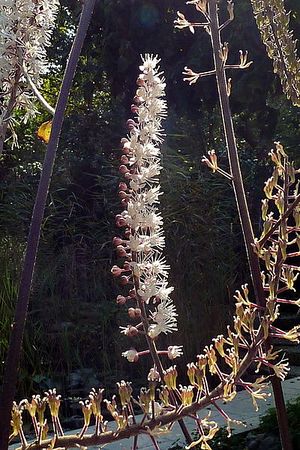Note: This is a project under development. The articles on this wiki are just being initiated and broadly incomplete. You can Help creating new pages.
Actaea racemosa - Black cohosh
Black Cohosh has been used by Native Americans for more than two hundred years, after they discovered the root of the plant helped relieve menstrual cramps and symptoms of menopause.
Contents
- 1 Uses
- 2 Parts Used
- 3 Chemical Composition
- 4 Common names
- 5 Properties
- 6 Habit
- 7 Identification
- 8 List of Ayurvedic medicine in which the herb is used
- 9 Where to get the saplings
- 10 Mode of Propagation
- 11 How to plant/cultivate
- 12 Commonly seen growing in areas
- 13 Photo Gallery
- 14 References
- 15 External Links
Uses
kidney issues, malaria, rheumatoid arthritis, joint inflammation, sore throat, helping with labor, menstrual cramps, menopause.
Parts Used
Chemical Composition
Black cohosh contains cimicifugin (macrotin) which has estrogenic effects. Also found in assay are acetein (antihypertensive effects) and ferulic/isoferulic acids (anti-inflammatory effects). The following components can also be found: isoflavones, salicyclic acid, tannins, resins, starch, and sugars[1]
Common names
| Language | Common name |
|---|---|
| Kannada | |
| Hindi | |
| Malayalam | |
| Tamil | |
| Telugu | |
| Marathi | NA |
| Gujarathi | NA |
| Punjabi | NA |
| Kashmiri | NA |
| Sanskrit | |
| English | Black snake root, bugbane |
Properties
Reference: Dravya - Substance, Rasa - Taste, Guna - Qualities, Veerya - Potency, Vipaka - Post-digesion effect, Karma - Pharmacological activity, Prabhava - Therepeutics.
Dravya
Rasa
Guna
Veerya
Vipaka
Karma
Prabhava
Habit
Identification
Leaf
| Kind | Shape | Feature |
|---|---|---|
| large | Alternate, Pinnate | The leaves are with deeply-cut segments |
Flower
| Type | Size | Color and composition | Stamen | More information |
|---|---|---|---|---|
| Unisexual | 14-18cm long | Yellow, Circular | Each bears one large flower the disk being yellow and the rays white, tinged with purple beneath. |
Fruit
| Type | Size | Mass | Appearance | Seeds | More information |
|---|---|---|---|---|---|
| Syncarp (sorosis), subglobose or ellipsoid with long echinate processes, orange when ripe | seeds many, ovoid. | {{{6}}} |
Other features
List of Ayurvedic medicine in which the herb is used
- Vishatinduka Taila as root juice extract
Where to get the saplings
Mode of Propagation
How to plant/cultivate
Aracemosa grows in dependably moist, fairly heavy soil. It bears tall tapering racemes of white midsummer flowers on wiry black-purple stems, whose mildly unpleasant, medicinal smell at close range gives it the common name "Bugbane"[3]
Commonly seen growing in areas
dry locations in sparse forests, hedges, forest clearings. .
Photo Gallery
Template:VI-tiny Actaea racemosa
Template:VI-tiny Actaea racemosa
References
External Links
- Ayurvedic Herbs known to be helpful to treat kidney issues
- Ayurvedic Herbs known to be helpful to treat malaria
- Ayurvedic Herbs known to be helpful to treat rheumatoid arthritis
- Ayurvedic Herbs known to be helpful to treat joint inflammation
- Ayurvedic Herbs known to be helpful to treat sore throat
- Ayurvedic Herbs known to be helpful to treat helping with labor
- Ayurvedic Herbs known to be helpful to treat menstrual cramps
- Ayurvedic Herbs known to be helpful to treat menopause
- Herbs with Dried Roots used in medicine
- Herbs with Leaves used in medicine
- Herbs with Flower used in medicine
- Herbs with common name in English
- Habit - Procumbent herb
- Index of Plants which can be propagated by Seeds
- Index of Plants which can be propagated by Cuttings
- Herbs that are commonly seen in the region of dry locations in sparse forests
- Herbs that are commonly seen in the region of hedges
- Herbs that are commonly seen in the region of forest clearings
- Herbs





